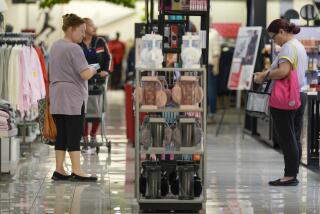Consumer Price Index Jumps 0.6% in November : ’85 Economic Growth Put at Weak 2.4%
WASHINGTON — The nation’s economy is expanding at a 3.2% annual rate during the year’s final three months, the government reported Friday, but economic growth for all of 1985 was a more sluggish 2.4%, the weakest since the current economic recovery began.
The Commerce Department’s preliminary “flash” estimate of growth--which usually is subject to revision as more accurate data becomes available--reflected a slight increase from 3% in the third quarter of 1985.
In a separate report, the Labor Department said that the consumer price index jumped 0.6% in November, the largest such increase since January of 1984, as sharp increases in the wholesale prices of food and energy worked their way into the retail market. But economists for the most part saw those increases as temporary, with inflation likely to hold near its present annual rate of 3.6%.
L.A. Inflation Rates
Retail prices in the Los Angeles-Long Beach-Anaheim metropolitan area decreased by 0.3% in November but have increased 4.3% over the last 12 months, contrasted with a 3.6% retail price inflation nationwide since last November.
In projecting 3.2% economic growth this quarter, the Commerce Department predicted slowing growth in imports, continued growth in retail sales, increased government spending and, for the first time in several months, substantial increases in business inventories as autos began accumulating on dealers’ lots again after last summer’s car-buying spree.
Those mixed signals left economists divided over the economy’s likely future.
David Wyss of Data Resources Inc., an economic forecasting firm in Massachusetts, predicted that the Commerce Department would lower its estimate of fourth-quarter economic growth as it gathered complete information on the economy’s performance in November and December. He said he believes that the department had underestimated the share of U.S. consumption that has been diverted from American manufacturers to imports.
Estimate ‘Reasonable’
But Allen Sinai, chief economist for the New York investment house of Shearson Lehman Bros., said, “The flash estimate seems reasonable.” However, he said that the estimate makes the economy look “better than it really is. Heavy auto inventories and government spending on Commodity Credit Corp. payments to farmers aren’t really signs of strength.”
And Irwin Kellner, chief economist at Manufacturers Hanover Bank, saw the return to inventory building as a good sign for the future.
“From mid-1984 to mid-1985,” he said, “the economy went through two major adjustments: the growth in the trade deficit and the sizable liquidation in inventory when manufacturers saw that the goods they were producing were not moving. Now, we can expect a better balance, as the dollar falls in value and imports slow down and exports expand.”
The Commerce Department’s preliminary economic growth estimate for all of 1985 fell short of the Reagan Administration’s most recent estimate.
At the beginning of 1985, the Administration projected that the nation’s economic output would be 4% greater at the end of the year than at the end of the previous year, but it lowered that estimate to 3% in August as the economy failed to shake off the doldrums that had set in midway through 1984.
For the first time, the department’s new estimate of economic output reflects a revised statistical yardstick for determining the size of the nation’s economy. The new system, which uses 1982 dollars instead of 1972 dollars to measure inflation-adjusted economic growth, shows the gross national product somewhat higher over the last decade or so than previously reported. But, partly because economic growth is now measured from a higher base, the new system shows annual growth rates to be slightly lower in most years.
The new system measures 1984 economic output at $3.775 trillion, an increase of $112 billion over the old system. This year’s gross national product is estimated at $3.993 trillion.
Shifts in Quarterly Rates
Although annual growth rates have been revised only slightly under the new measure, quarterly growth rates in some cases have shifted sharply up or down. Growth for the July-to-September quarter of this year, for example, was lowered to 3% from 4.3%.
Changes in the reporting of trade data account for much of the swing in the quarterly growth reports. The Commerce Department ascribed imports and exports to the months in which they occurred instead of, as previously, logging them in the month that trade documents were processed.
That accounting change pushed growth for the fourth quarter of last year down from 4.3% to 0.6%. But the same process showed growth the first quarter of this year to be a respectable 3.7%, rather than the near-stagnation rate of 0.3%.
As for inflation, economists generally agreed that the 0.6% jump in November retail prices was caused by a temporary spurt in food and energy prices. Inflation should subside in the months ahead, they said.
Kellner and Sinai warned that higher rates of inflation are likely sometime in 1986 if the dollar continues to drop in value against foreign currencies.
ECONOMIC GROWTH SINCE 1972
(Adjusted for inflation, as estimated under previous and revised procedures)
Year Old way New way 1972 5.7% 4.9% 1973 5.8 5.2 1974 -0.6 -0.5 1975 -1.2 -1.3 1976 5.4 4.9 1977 5.5 4.7 1978 5.0 5.3 1979 2.8 2.5 1980 -0.3 -0.2 1981 2.5 1.9 1982 -2.1 -2.5 1983 3.7 3.4
Quarter
1984 I 10.1 11.4 II 7.1 5.1 III 1.6 2.1 IV 4.3 0.6 1985 I 0.3 3.7 II 1.9 1.1 III 4.3 3.0
Source: Commerce Department
More to Read
Inside the business of entertainment
The Wide Shot brings you news, analysis and insights on everything from streaming wars to production — and what it all means for the future.
You may occasionally receive promotional content from the Los Angeles Times.










